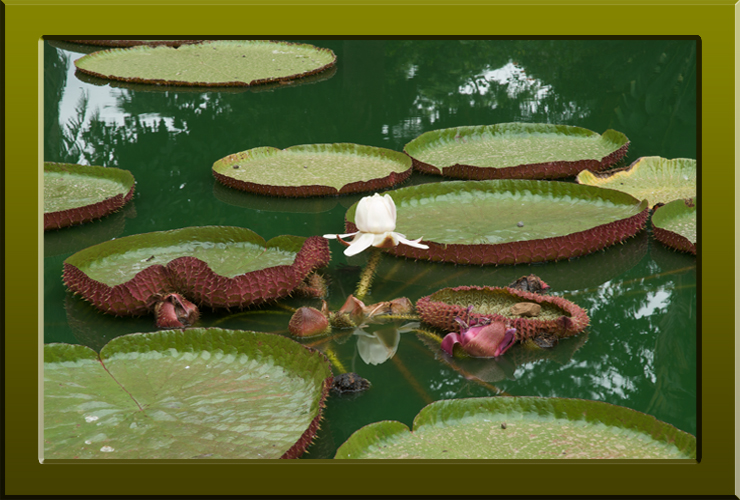Amazonian BioProvince
This BioProvince (as defined by Armen Takhtajan) basically comprises the Amazonian Basin. The Amazon has a typical tropical climate with high rainfall and high humidity. The seasons are relatively static, with an average temperature of 27°C during the day, but at night it can fall to about 10°C. Heavy rainfall normally occurs in short durations and the wettest period is from January to April. The Amazon Basin is one of the World’s largest subsidence troughs extending some 6 million square kms and straddles the border of Brazil, Colombia, Guyana, French Guyana, Surinam and Venezuela, and contains about 20% of the World’s fresh water. Sediments have been accumulating in this basin for approximately 500 million years and as a consequence it contains a huge volume of sediment. At the mouth of the Amazon, for example, this has created a number of sedimentry island including Marajó, which is the largest fluvial island created from river-borne sediments in the World (about the size of Switzerland). The Amazon River itself flows for some 4000 miles from the Andes to the Atlantic. This makes it the second longest river in the World after the Nile, but it is the largest in the World in terms of the size of its watershed, its number of tributaries, and the volume of water it discharged into the sea. Amazonia forests have been broadly classified into terra firme (unflooded forest), seasonal várzea (forest flooded periodically by white-water or water rich in suspended sediments), seasonal igapó (forest flooded periodically by black or clear water low in suspended sediments) and tidal várzea (forest flooded twice daily by freshwater backed by the incoming tide). There are also permanent white-water swamp forest and permanent igapó but tidal igapó does not seem to occur. Flood forests tend to have a lower alpha-diversity than terra firme forest, but their beta-diversity may be higher due to the more heterogenous nature of their terrains. However, these forests are not only special for their globally important levels of biodiversity they also generate up to 75% of the rainfall in Amazonia through evapotranspiration and they produce more than 20% of the World's oxygen supply.
The flora in Amazonia is extremely rich with three endemic families (Dialypetalanthaceae, Duckeodendraceae and Rhabdodendraceae), at least 100 endemic genera and about 3000 endemic species. Despite the fact that that Amazonian forests often looks fairly homogenous from the air at least 13 centres of plant endemism have been recognised. These include the Imataca Centre, situated on the the Venezuela-Guiana border in the northeast corner of Bolivar State and the southwestern Delta Amacuro State of Venezuela, the West Guiana Centre, which include much of Guyana and Surinam, the East Guiana Centre, which equates to French Guiana, the Imeri Centre, situated in the Venezuela-Brasil-Columbia borderlands and centred on the upper Rio Negro basin, the Napo Centre situated in the Rio Napo area in Western Amazonia, the São Paulo de Olivenca Centre, which includes the area around the small community São Paulo de Olivenca in Western Brazil on the upper Amazon, the Tefé Centre based on the Tefé tributary in western Brazil, the Manaus Centre, situated around Manaus in Central Amazonia, the Rio Trombetas Centre, based on the Rio Trombetas basin in northern Brazil, the Belém Centre, situated near the mouth of the Amazon, the Tapajós Centre, situated around the Tapajós tributary southeast of Manaus, the Rondônia-Aripuanã Centre, extending from the small community of Rondônia to the Aripuanã tributary in western Brazil, and the East Peru-Acre Centre based on the area around eastern Peru (on the Peru-Bolivian border) and the River Acre in Brazil.
The following accounts for this BioProvince have been written or will be written with particular reference to endemic and locally important species. Accounts available are displayed in green or yellow. Those displayed in red are either in the pipeline or awaiting expert contributions.
| Index |
|---|
| Major Ecosystems |
| Vascular Plant Flora |
| Bryophyte Flora |
| Fungus Flora |
| Lichen Flora |
| Invertebrate Fauna |
| Amphibian Fauna |
| Reptile Fauna |
| Bird Fauna |
| Mammal Fauna |
| Conservation Status |

Victoria amazonica native to the shallow waters of the Amazon Basin and the largest member of the water lily family Nymphaeaceae (Copyright © 2010 Peter Martin Rhind).


